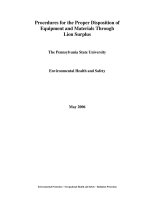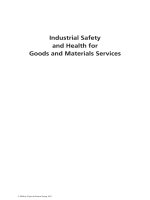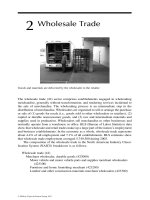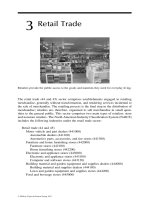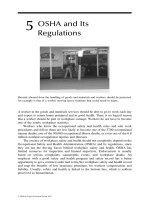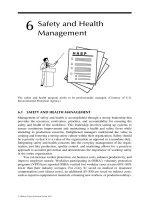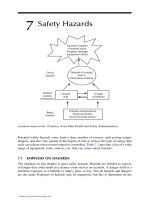Industrial Safety and Health for Goods and Materials Services - Chapter 11 pot
Bạn đang xem bản rút gọn của tài liệu. Xem và tải ngay bản đầy đủ của tài liệu tại đây (307.02 KB, 18 trang )
11
Controls and PPE
11.1 HAZARD PREVENTION AND CONTROLS
The Occu pational Safety and Health Admini stration (OSHA) require employers to
protect their employees from workplace hazards such as machines, work procedures,
and hazardous substances that can cause inju ry or illnesses. It is known from past
practices and situations that something must be done to mitigate or remove hazards
from the workplace. Actions taken often create other hazards, which had not existed
before attempting to address the existing hazard.
Many companies have suggestion programs where workers receive rewards for
suggestions that are implemented. It is no surprise that the person who often has the best
ideas is the one who suffers most from that particular hazard. It is a sound management
process to involve those who are impacted most in decision-making processes.
Safety toed shoes, safety eyewear, head protection, ear protection, and hand protection are all
forms of personal protective equipment.
ß 2008 by Taylor & Francis Group, LLC.
Several methods have been used over the years to control hazards and these can
be segregated into five categories. The preferred methods are engineering controls,
awareness devices, predetermined safe work practices, and administrative controls.
When these controls are not feasible or do not provide sufficient protection, an
alternative or supplementary method of protection is to provide workers with
personal protective equipment (PPE) and the know-how to use it properly.
11.2 ENGINEERING CONTROLS
When a hazard is identified in the workplace, every effort should be made to eliminate
it so that employees are not harmed. Elimination may be accom plished by designing or
redesigning a piece of equipment or process. This could be the installation of a guard
on a piece of machinery, which prevents workers from contacting the hazard. The
hazard can be engineered out of the operation. Another way to reduce or control the
hazard is to isolate the process, such as in the manufacture of vinyl chloride used to
make such items as plastic milk bottles, where the entire process becomes a closed
circuit. This will result in no one being exposed to vinyl chloride gas, which is known
to cause cancer. Thus, any physical controls which are put in place are considered to be
the best approach from an engineering perspective. Keep in mind that you are a
consumer of products. Thus, at times you can leverage the manufacturer to implement
safeguards or safety devices on products that you are looking to purchase. Let your
vendor do the engineering for you or do not purchase their product. This may not
always be a viable option. To summarize the engineering controls that can be used, the
following may be considered:
.
Substitution
.
Elimination
.
Ventilation
.
Isolation
.
Process or design change
11.3 AWARENESS DEVICES
Awareness devices are linked to the senses. They are warning devices, which can be
heard and seen. They act as alerts to workers, but create no type of physical barrier.
They are found in most workplaces and carry with them a moderate degree of
effectiveness. Such devices are as follows:
.
Backup alarms
.
Warning signals both audible and visual
.
Warning signs
11.4 WORK PRACTICES
Work practices are the means by which a job task or acti vity is done. This may mean
that you create a specific procedure for completing the task or job. It may also
ß 2008 by Taylor & Francis Group, LLC.
mean that you implement special training for a job or task. It also presupposes that
you might require inspection of the equipment or machinery before beginning work
or when a failure has occurred. An inspection should be done before restarting the
process or task. A lockout=tagout procedure may also be required to creat e a zero
potential energy release.
11.5 ADMINISTRATIVE CONTROLS
A second approach is to control the hazard through administrative directives. This may
be accomplished by rotating workers, which allows you to limit their exposure, or
having workers only work in areas when no hazards exist during that part of their shift.
This applies particularly to chemical exposures and repetitive activities that could result
in ergonomic related incidents. Examples of administrative controls are as follows:
.
Requiring specific training and education
.
Scheduling off-shift work
.
Worker rotation
11.5.1 MANAGEMENT CONTROLS
Management controls are needed to express the company’s view of hazards and their
response to hazards that have been detected. The entire program must be directed
and supported through the management controls. If management does not have a
systematic and set procedure for addressing the control of hazards in place, the
reporting=identifying of hazards is a waste of time and money. This goes back to the
policies and directives and the holding of those responsible accountable by providing
them with the resources (budget) for correcting and controlling hazards. Some
aspects of management controls are as follows:
.
Policies
.
Directives
.
Responsibilities (line and staff)
.
Vigor and example
.
Accountability
.
Budget
The attempt to identify the worksite hazards and address them should be an integral
part of your management approach. If the hazards are not addressed in a timely
fashion, they will not be identified or reported. If money becomes the main criterion
for not fixing or controlling hazards, your workforce will lose interest in identifying
and reporting them.
11.6 PERSONAL PROTECTIVE EQUIPMENT
Personal protective equipment includes a variety of devices and garments to protect
workers from injuries. You can find PPE designed to protect eyes, face, head, ears,
feet, hands and arms, and the whole body. PPE includes such items as goggles, face
ß 2008 by Taylor & Francis Group, LLC.
shields, safet y glasses, h ard hats, safet y shoes, gloves, vests, earpl ugs, earm uffs, and
suits for full body protectio n.
11.6.1 HAZARD ASSESSMENT
Recent regul atory requireme nts make hazard analys is=asses sment part of the
PPE selection proces s. Haza rd analys is=asses sment procedu res shall be used to
assess the wor kplace to d etermine if haz ards are p resent, or are like ly to be presen t,
which may necess itate the use of PPE. As part of this asses smen t, employe es’
work envir onment is to be examined for potential healt h a nd physi cal hazards. If it
is not possi ble to elimin ate wor kers’ exposur e or potential exposur e to the hazard
through the effor ts of engine ering controls, work p ractices, and adminis trative
controls, then the proper PPE will need to be used. The hazard assessment certifica-
tion form found in Appen dix C may be of assistanc e in co nducting a hazard
analysis=assessment.
When employees must be present and engineering or administrative controls
are not feasible, it will be essential to use PPE as an interim control and not a
final solution. For example, safety glasses may be required in the work area. Far too
often, in the scheme of hazard control PPE usage is considered as a last resort. PPE
can provide added protection to the employee even when the hazard is being
controlled by other means. There are drawbacks to the use of PPE and they are
as follows:
.
Hazard still looms
.
Protection dependent upon worker using PPE
.
PPE may interfere with performing task and productivity
.
Requires supervision
.
Is an ongoing expense
Many forms of PPE need to be addressed and required when a hazard assessment
determined that PPE is the only option left for protecting the workforce. PPE
includes the following:
.
Eye and face protection (29 CFR 1910.133)
.
Respiratory protection (29 CFR 1910.134)
.
Head protection (29 CFR 1910.135)
.
Foot and leg protection (29 CFR 1910.136)
.
Electrical protective equipment (29 CFR 1910.137)
.
Hand protection (29 CFR 1910.138)
.
Respiratory protection of tuberculosis (29 CFR 1910.139)
Any other types of specialized protective equipment needed would be identified
as part of the hazard assessment. Such equipment might include body protection
for hazardous materials, protective equipment for material handling, protection for
welding activities, or protection from exposure to biological agents.
ß 2008 by Taylor & Francis Group, LLC.
11.6.2 ESTABLISHING A PPE P ROGRAM
A PPE progra m sets out procedu res for selec ting , provi ding, a nd using PPE as part of
an organi zation ’ s routi ne operat ion. A written PPE progra m, alth ough not manda -
tory, is easie r to estab lish a nd mai ntain than a compa ny policy and easie r to evaluate
than an unwrit ten one. To develo p a writt en progra m you shoul d consider including
the follow ing elem ents or informat ion:
.
Identify steps taken to asses s potent ial hazards in every empl oyees ’ work-
space and in workplace operating procedu res.
.
Identify appropriat e PPE selec tion criteria .
.
Identify how you will train empl oyees on the use of PPE, including the
following:
.
W hat PPE is necess ary.
.
W hen is PPE necess ary.
.
How to proper ly inspe ct PPE for wear and damag e.
.
How to proper ly put on and adjus t the fit of PPE.
.
How to proper ly take off PPE.
.
Li mitations of PPE.
.
How to proper ly care for and store PPE.
.
Identify how you will asses s empl oyee understandi ng of PPE training.
.
Identify how you will enforc e proper PPE use.
.
Identify how you will provi de for any required medica l examinati ons.
.
Identify how and when to e valuate the PPE progra m.
Finally, use PPE for potential ly dan gerous co nditions . Use gloves , aprons , and
goggles to avoid acid splashing . Wea r earplugs for protectio n from high noise levels
and wear respi rators to protect agains t toxi c chemicals . The use of PPE should be the
last consi deration in eliminatin g or reduci ng the hazards the employee is subjected to
because PPE can be heavy, awkwar d, unc omfortable, and expensi ve to mai ntain.
Therefore, try to engineer the identified hazards out of the job.
11.7 RANKING HAZARD CONTROLS
In determining which hazard control procedures have the best chance of being effective,
it is useful to rank them along a continuum. The five hazard controls that were espoused
in the earlier part of this chapter are ranked in Figure 11.1. This should assist you in
determining, which control, if you have a choice of more than one, would be most
effective for your purposes. The ranking goes from most effective to least effective.
11.8 PPE POLICIES
Companies should have policies regarding PPE and clothing that is appropriate for
work. Companies must have policies regarding hair length=style and wearing of
protective equipment when it impedes upon proper wearing and use. Disciplinary
ß 2008 by Taylor & Francis Group, LLC.
Elimination or substitution
Most
effective
More
effective
Lesser
effective
Least
effective
Awareness means
Training and procedures
(administrative controls)
Personal protective equipment
Engineering controls (safeguarding
technology)
•
Change the process to eliminate
human interaction
•
Elimination of pinch points
(increase clearance)
•
Automated material handling
•
Mechanical hard stops
•
Lights, beacons, and strobes
•
Computer warnings
•
Painted markings on floors for
restrictive areas or envelopes
•
Beepers
•
Alarms
•
Horns
•
Labels
•
Public address systems
•
Training
•
Job rotation
•
Off shift scheduling of work
•
Safety equipment inspections/audits
•
Lockout/tagout
•
Safety eyewear (face shield)
•
Hearing protection (ear plugs or muffs)
•
Fire proof clothing
•
Gloves
•
Safety shoes
•
Respirators
•
Whole body protection (Tyveks)
•
Safe job procedures
•
Signs
•
Barriers
•
Interlocks
•
Presence sensing devices
•
Two-hand controls
FIGURE 11.1 Ranking hazard controls.
ß 2008 by Taylor & Francis Group, LLC.
measures should be set and be taken if employees fail to adhere to appropriate dress
regulations and requirements for wearing PPE.
11.8.1 SAFETY CLOTHING
For some jobs, ordinary clothing— clean, in good repair, and suited to the work
involved—may be considered ‘‘safe.’’ A few items are important such as the
following:
.
Good fit is important.
.
Trousers should not be too long.
.
Cuffs should never be worn while performing operations that produce
flying embers, sparks, or other harmful matter that might get caught.
.
Loose-fitting garments should be avoided.
Safety precautions regarding regular work clothes should include the follow ing:
.
Do not wear anything that could get caught in a machine
.
No neckties or scarves that go around the neck
.
No wristwatches with buckle or clamp-on bands
.
No rings, necklaces, bracelets, or dangling earrings
.
No shirts with dangling cuffs or tails
.
No gloves around rotating machinery
.
No clothing soaked in oil or flammable solvent
Do not buy poorly made or low-quality work clothes; well-made clothes may cost a
little more, but they fit better, last longer, and are safer and more comfortable.
Replace or repair torn or worn-out items immediately. Keep your work clothes
clean; dusty or dirty clothes can cause skin rash and irritation. Do not cut corners by
wearing old dress shoes for work; well-built shoes in good condition with sensible
heels are safer, and they cut down on fatigue.
For jobs involving exposure to fire, extreme heat, molten metal, corrosive
chemicals, cold temperatures, cuts from handling materials, etc., special protective
clothing may be required.
11.8.2 SPECIAL PROTECTIVE CLOTHING
Many types of protective clothing are available and used to protect against certain
hazards such as the following:
.
Aluminized and reflective clothing: Reflects radiant heat
.
Flame-resistant cotton fabric: Often used as hair covering for people who
work near sparks and open flames
.
Impervious materials (rubber, neoprene, vinyl, etc.): Protect against dust,
vapors, mists, moisture, and corrosives
.
Leather clothing: Protects against light impact, sparks, molten metal
splashes, and infrared and ultraviolet radiation
ß 2008 by Taylor & Francis Group, LLC.
.
Synthetic fibers (Orlon, Dyne l, Vinyo n, etc.): Resist acids, many solve nts,
mildew, abrasi on and tearin g, and repeat ed launderings
.
Water-res istant duck: Protec ts from wat er and noncorr osive liqu ids
.
Glass fi ber: Used in multilayer constructi on to insulate clothing
11.8.3 SAFETY AND HAIR P ROTECTION
Head guards , caps, nets, etc., are designed to keep h air from catchin g in machinery.
Flame-res istant headgear should be wor n for wor k around sparks or flames . Hair
length poses addit ional probl ems with regard to safet y equipment such as the
following:
.
Men with extremel y long, heavy sideb urns may fi nd it dif ficult to get a
proper fit when wear ing heari ng protectio n earm uffs.
.
Large, bushy mustaches and beards can interfere with the p roper fitting of
respirato ry equipm ent and breat hing apparat us.
.
Long or b ushy hair may make it difficult to wear a safety hat.
11.8.4 PROTECTING THE HEAD
Head protectio n is needed by all empl oyees engaged in occupat ions that pose specia l
hazards to the head. These hazards are as follow s:
.
Falling objects
.
Flying particles
.
Electric shock
.
Overhead spills of chemi cals, acid, o r hot liquids
Some of the parti cularly high-risk indus tries are tree trimm ing, const ruction work,
shipbuil ding, logging, min ing, overhea d line const ruction or mai ntenan ce, and metal
or chemical production.
Types of protective headgear and what they are designed to protect the head from
are as follows:
.
Safety helmets or hard hats with full brim from most of the major hazards
regard ing the he ad (Figur e 11.2).
.
Bump caps—for use where a brim might get in the way; in confined spaces
where exposure is limited to bumping; should never be worn where there is
exposure to more serious hazards.
.
Hair protection caps—for use by employees with long hair who work
around chains, belts, or other machines.
Some of the key design features are the suspension that maintains the distance
between the top of a head and the helmet shell is known as the ‘‘crown clearance’’;
it determines the amount of protection offered against impact and penetration.
A suspension that is too rigid can transmit the shock of impact and fracture the
neck vertebrae. A suspension that is too flexible permits contact with the head upon
ß 2008 by Taylor & Francis Group, LLC.
impact, causing skull fracture or concussion. A damaged or worn suspension should
be replaced immediately.
A chin strap: made of leather, fabric, or elastic; prevents the hat from falling off or
being blown off. During cold weather a liner for warmth can be worn under the hard
hat. Also, an eye shield and hearing protection muffs may be attached if required.
Some of the safety precautions that should be followed regarding hard hat
protection are as follows:
.
Never leave a safety helmet on the rear window shelf of an auto or truck;
sunlight may affect its prote ctive quality, and an emergency stop can turn
the helmet into a dangerous missile.
.
Never keep anything under the safety hat between crown and suspension
such as personal items (wallet); it interferes with the suspension.
.
Clean the hat and suspension regularly (at least every 30 days).
.
Never attempt to repair the shell of a hat once it has been broken or
punctured.
.
Never drill holes in a safety hat to ‘‘improve ventilation’’ or cut notches in
the brim.
.
Replace a damaged helmet immediately.
.
If the hat is giving you a headache, make sure it is fitted properly.
.
Never remove the suspension for any reason.
11.8.5 PROTECTING THE EYES AND FACE
Industrial eye injuries occur at a rate of 2=min and are the costliest in terms of lost
production and earning power. Of the more than 1000 industrial eye injuries that
occur every working day, over 90% of them are needless and preventable. The
primary causes of on-the-job eye injuries are as follows:
FIGURE 11.2 Hardhat with ear protection and chin strap.
ß 2008 by Taylor & Francis Group, LLC.
.
Flying objects (especially those set in motion by hand tools)
.
Abrasive wheels (small flying particles)
.
Fragments from hammering or sawing
.
Corrosive substances
.
Injurious light or heat rays
.
Splashing metal
.
Poisonous gas or fumes
To prevent injury to the eyes workers should wear the proper eye protection such as
any of the following:
.
Cover goggles
.
Protective spectacles=safety glasses
.
Protective spectacles with side shields
.
Chemical or splash-resistant goggles
.
Dust goggles
.
Melters’ goggles
.
Welders’ goggles
Make sure the goggles or glasses are comfortable and properly fitted. Fitting,
adjusting, and maintaining eye equipment is a part of the wearing process. At
times the use of defogging materials helps. Protec tive eyewear should be cleaned
regularly and the use of sweatbands can be helpful.
Today with the variety of styles there are no excuses for failing to wear safety
goggles. Get them adjusted or refitted by a professional. Clean protective eyewear
regularly; keep them in a case or a place where they would not get scratched. Secure
adjustable suspension to make the fit more accommodating on a daily basis; see an
eye doctor if headaches or discomfort persist. An employer should not accept any
excuse for not wearing protective eyewear.
Do not wear contact lenses where there are considerable amounts of dust, smoke,
irritating fumes, or liquid irritants that could splash into the eyes. Never wear contact
lenses as a substitute for protective eye equipment. If you must wear contact lenses
on the job, get written authorization from your eye doctor and wear safety goggles
over your contacts.
Wear your safety goggles at home too (when using power tools, spray painting,
etc.). Know the appropriate first-aid measures for eye emergencies; for example,
flushing eye with water if a chemical has been splashed.
Face protection is most needed when the following hazards to the face and neck
are present:
.
Flying particles
.
Sprays of hazardous liquids
.
Splashes of molten metals
.
Hot solutions
ß 2008 by Taylor & Francis Group, LLC.
Face protectiv e equipm ent such as face shiel ds shoul d be used when saw ing or
buf fing, sandi ng or ligh t grinding, and handling che micals, and helm ets must be
worn when wor king with molten met al and radia tion. Hand held shield c an be used
for inspe ction wor k, tack welding , etc. At tim es the use of acid-proof hoods with
corrosive chemi cals or hoods wi th air suppl y for toxic fume s, dusts, mis ts, and gases
may be used as part of face protectio n.
11.8.6 EAR P ROTECTION
Hearing protectio n is needed when
.
Noise stand ards a re exceeded or the compa ny noise levels meas ureme nt
exceeds accep table levels.
.
Engineer ing contr ols currently in use to decreas e noise level s (acous tica l
enclosures, etc.) are not effect ive.
.
Audiom etric testing progra m deter mines a wor ker ’s condit ion has worsened
since the last test ing.
.
Sources of ‘‘ noise polluti on’’ in the working environmen t have remained
undetected and effectiven ess of existing engine ering controls has n ot been
suffi cient.
There are two types of hearing prote ction: aural type— placed inside the ear canal;
and super- aural type — sealing the external edg e of the ear canal. Rubbe r, plastic, or
wax is used most commonl y and cotton offer s no prote ction.
The imp ortance of proper fit is essent ial when it comes to heari ng prote ction.
Some of the procedu res that must be conside red for fitting are as follow s:
.
Possible discomfor t if p oints of press ure dev elop.
.
Good seal cannot be obtained without some initial disco mfort.
.
There shoul d be no lasting probl ems if earplugs are made of soft mat erial
and kep t clean.
Complaint that earplugs make it difficult to hear convers ation. (Tests show that when
noise level is higher than 85 dB, speech is more ea sily unders tood with earplugs in
place than without them.)
Muff-type protectors’ cup or muff covers the external ear to provide an acous-
tical barrier. Liquid or grease-filled cushions give better noise suppression than
plastic or foam rubber types, but may present leakage problems. Head size and
shape also affect noise suppre ssion (Figur e 11.3).
Helmet protectors completely surround the head. Suppression of sound is
achieved through the acoustical properties of the helmet. Cost and bulk norm ally
preclude use of helmet for most jobs.
Commercially available hearing protection is very effective if properly fitted and
used; earplugs generally reduce the amount of noise reaching the ear by 25–30 dB
ß 2008 by Taylor & Francis Group, LLC.
in the higher frequencies, which are the most harmful. The bett er type of earmuffs
may reduce noise by an additional 10–15 dB. A Combination of earplugs and
earmuffs gives an additional 3–5 dB of noise protection.
11.8.7 PROTECTING YOUR HANDS
Certain mechanical actions can trap hands and cause serious injuries or amputations.
The following are five such actions that can damage hands and fingers:
.
Shearing—Examples include ordinary scissors, guillotine cutters, cleavers,
axes, knives, screw or worn conveyors, any two hard-edged objects that
pass close together. Keep hands and fingers away from any tight places that
can present slicing hazards.
.
Rotating (spinning motion may have a horizontal or vertical axis, or it may be
at an angle)—Examples include rotary saw, fan blades, lathe, and power drills.
Watch out for toothed, spike, or jagged edges that can slash into fingers.
.
In-running nip from any parallel wheels, rollers, or shafts turning inward
together—Examples include gears, belt and pulley, rack and pinion, chain
and sprocket. Learn to recognize and stay clear of the grabbing power of the
in-running nip.
.
Puncturing from any device or tool that can penetrate flesh if it slips or goes
out of control—Examples include screwdriver, awl, and knife points.
Remember that a puncture can be twice as dangerous as a superficial cut
because it carries the threat of deep infection; get first aid right away.
.
Smashing—Examples include hammer, factory presses, ‘‘pinch points.’’
Watch out when putting down heavy objects, moving loads through doorways, and
maneuvering drums and cylinders.
FIGURE 11.3 The use of ear muffs and safety eyewear with side shields.
ß 2008 by Taylor & Francis Group, LLC.
Gloves are the most common hand and finger protectors. There are many
different types of gloves and e ach has its own unique benefits. Some examples of
types of gloves are as follows:
.
Heat resistant gloves that protect against burns and discomfort when hands
are exposed to heat.
.
Metal mesh gloves , used by those who work with knives, protect against
cuts and blows from sharp objects. Kevlar gloves offer some degree of cut
resistance as shown in Figure 11.4.
.
Rubber gloves are worn by electricians to keep hands insulated from shock.
.
Rubber, neoprene, and vinyl gloves are used when handling chemicals and
corrosives. These gloves should be selected from a glove chart to protect
against the specific chemical being used.
.
Leather gloves resist sparks, moderate heat, protect from sharp edges, and
cushion against blows.
.
Chrome-tanned cowhide gloves with a steel-stapled leather patch on palms
and fingers are often used in foundries and steel mills.
.
Cotton or fabric gloves provide suitable protection against dirt, chafing, or
abrasion.
.
Coated fabric gloves protect against moderately concentrated chemicals.
.
Hand leathers or hand pads are often better than gloves for protection
against heat, abrasion, and splinters.
FIGURE 11.4 Cut resistant Kevlar gloves.
ß 2008 by Taylor & Francis Group, LLC.
Some basic safety precautions that can help further protect hand, finger, and arms are
as follows:
.
Never try to ‘‘cheat’’ a guard or any safety device.
.
Disconnect power to clean, oil, or adjust a machine; lock it out if work rules
require it.
.
Remove rings, watchbands, bracelets, etc., when working with machinery.
.
Use gloves to protect your hands from chemicals and rough objects; but
never wear them around moving machinery.
.
Use the right tools and keep your hands out of tight places.
.
Use a brush or hook—not bare hands—to clear away filings or shavings
from work areas.
.
If an accident occurs, get first aid right away.
.
Remember that a puncture can be twice as dangerous as a superficial cut
because it carries the threat of deep infection; get first aid right away.
11.8.8 PROTECTING THE FEET AND LEGS
About a quarter of a million disabling occupational foot injuries occur each year.
A Bureau of Labor Statistics study conducted in 1981 revealed that over 75% of
foot injuries happened to workers who were not wearing safety shoes. The major
causes of foot related accidents are as follows:
.
60% from falling objects
.
16% from stepping on a sharp object
.
13% from feet being struck by rolling objects
The types of safety shoes and their uses are as follows:
.
Metal-free shoes, boots, etc., are used where there are specific electrical
hazards or fire and explosion hazards.
.
Gaiter-type shoes protect people from splashes of molten metal or welding
sparks.
.
Shoes with reinforced soles or innersoles of flexible metal are worn where
there are hazards from protruding nails, etc.
.
Rubber boots and shoes, leather shoes with wooden soles, or wood-soled
sandals are used for wet work conditions.
.
Safety shoes with metatarsal guards are worn for operations involving the
handling of heavy materials (pig iron, heavy castings, timber, etc.).
Workers do not wear safety shoes, needlessly exposing themselves to injury and
disablement, because they complain that they are hot, heavy, and uncomfortable.
Many safety shoes nowadays are as comfortable, practical, and attractive as ordinary
street shoes. The steel cap weighs about as much as a wristwatch. The toe box is
insulated with felt to keep the feet from getting too hot or cold. At times workers
object to wearing safety shoes because the steel caps do not cover the smallest toes.
ß 2008 by Taylor & Francis Group, LLC.
Studies show that 75% of all toe fractures happen to the first and second toes. In most
accidents, the toe box takes the load of the impact for the entire front part of the foot.
Also, workers are afraid that if the toe box were crushed, the steel edge would cut off
their toes. In reality, accidents of this type are rare; in the majority of cases, safety
shoes give sufficient protection. A blow that would crush the toe cap would certainly
smash one’s toes since the toe cap is designed to withstand approximately 2500 lb of
force (Figure 11.5).
Leg protection, such as leggings that encircle the leg from ankle to knee and have a
flap at the bottom to protect the instep, are worn to prote ct the entire leg. These should
be easily removed in case of emergency. Shin guards made of hard fiber or met al are
worn to protect the shins against impact. Knee pads protect employees whose work
requires a great deal of kneeling, such as cement finishing or tile setting. Ballistic
nylon pads are used to protect the thighs and upper legs against injury from chain saws.
11.8.9 RESPIRATORY PROTECTION
It is desirable to wear respiratory protection when air contaminants range from
relatively harmless substances to toxic dusts, vapors , mists, fumes, and gases that
may be extremely harmful. Standards specify ‘‘safe levels’’ of certain airborne
contaminants and they are exceeded. Ideally, these safe levels c an be achieved
through engineering controls. When engineering controls are not technically feas-
ible, or when the hazardous operation is performed only infrequently (making these
controls impractical), respiratory protection is needed. Respiratory equipment should
also be regarded as emergency equipment (e.g., in cases of leaks and breakdowns).
While selecting the proper respiratory equipment, the following factors should
be taken into consideration:
.
Nature of the hazardous operation or process
.
Type of air contaminant, including its physical properties, chemical prop-
erties, physiological effects on the body, and its concentration
.
Period of time for which respiratory protection must be provided
.
Location of the hazard with respect to a source of uncontaminated air
.
Employee’s state of health
.
Functional and physical characteristics of the various respiratory devices
Hidden metal
toe guard
Safety shoe with
metal toe guard
FIGURE 11.5 Example of safety toed shoes. (Courtesy of the Department of Energy.)
ß 2008 by Taylor & Francis Group, LLC.
Using the wrong kind of respirator for the hazard involved can be dangerous: For
example, particulate filter respirators are of no value as protection against solvent
vapors, injurious gases, or lack of oxygen.
The types of respirators and their uses commonly dictate the appropriate respir-
ator. Some the most common respirators are as follows:
.
Air-purifying respirators remove contaminants from the air being inhaled.
Examples of air- purifying respirators are gas masks, chemical cartridge,
respirators, particulate filter respirators, and combination respirators
(Figure 11.6).
.
Air supplied respirators deliver breathing air through a supply hose con-
nected to the wearer’s facepiece. Some of the varieties of this type of
respirator are hose masks, air line respirators, abrasive blasting respirators,
and air supplied suits and hoods.
.
Self-contained breat hing apparatus (SCBA) devices afford complete
respiratory protection in any toxic or oxygen-deficient atmosphere. The
types of SCBAs are oxygen re-breathing, self-generating, demand, and
pressure-demand.
Care of respiratory devices is important since a worker’s life may depend upon the
proper function and use of the respirator. It is important that the following practices
be followed:
.
Schedule for cleaning and repair of respirators
.
Inspection procedures and schedule
.
Methods of disinfection
.
Preventive maintenance steps
It is important that workers keep respirators on at all times when working in a
contaminated atmosphere.
Full-facepiece,
dual cartridge
Half-mask, facepiece-
mounted cartridge
FIGURE 11.6 Examples of air-purifying respirators. (Courtesy of the National Institute for
Occupational Safety and Health.)
ß 2008 by Taylor & Francis Group, LLC.
11.9 SUMMARY
It is the employers’ responsibility to provide the employee with the required PPE. It
is the employee’s responsibility to take care and keep the PPE clean and assure that it
is in good shape. If it is not, it should be returned to the employer for repair or
replacement.
ß 2008 by Taylor & Francis Group, LLC.
ß 2008 by Taylor & Francis Group, LLC.
